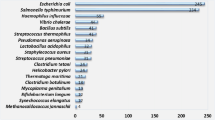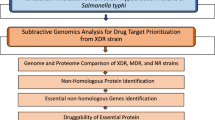Abstract
Neisseria gonorrhoeae, a World Health Organization (WHO) declared superbug and the second-most frequent cause of bacterial sexually transmitted infections worldwide is responsible for gonorrhea. Hypothetical proteins are gene products that are predicted to be encoded by a particular gene based on the DNA sequence, but their specific functions and characteristics have not been experimentally determined or verified. In the context of this research, annotating hypothetical proteins is crucial for identifying their potential as therapeutic targets. Without proper annotation, these proteins would remain vague, hindering efforts to understand their roles in disease. The methodology used aims to bridge this gap by employing algorithm-based tools and software to annotate hypothetical proteins and assess their suitability as therapeutic targets based on factors such as essentiality, virulence, subcellular localization, and druggability. Out of 716 N. gonorrhoeae hypothetical proteins reported in UniProt, assessment of crucial pathogenic factors, including essentiality, virulence, subcellular localization, and druggability, effectively filtered and prioritized the hypothetical proteins for further therapeutic exploration and lead to 5 proteins being chosen as targets. The molecular docking studies conducted identified 10 hits targeting the five targets. Conclusively, this study aided in identification of targets and hit compounds for therapeutic targeting of gonorrhea disease.
Graphical abstract








Similar content being viewed by others
Availability of data and material
All data generated or analysed during this study are included in this published article [and its supplementary information files].
Abbreviations
- HP:
-
Hypothetical proteins
- ENH:
-
Essential non-homologous
- ORF:
-
Open reading frame
- DEG:
-
Database of essential genes
- DUF:
-
Domains of unknown functions
- BUSCA:
-
Bologna Unified Subcellular Component Annotator
- PSSM:
-
Position specific scoring matrix
- SVM:
-
Support vector machine
- HPIDB:
-
Host pathogen interaction database
- PPI:
-
Protein–protein interactions
- I-TASSER:
-
Iterative threading assembly refinement
- SAVES:
-
Structure analysis and verification server
- RMSD:
-
Root mean square deviation
References
Altschul SF, Gish W, Miller W, Myers EW, Lipman DJ (1990) Basic local alignment search tool. J Mol Biol 215(3):403–410. https://doi.org/10.1016/S0022-2836(05)80360-2
Ammari MG, Gresham CR, McCarthy FM, Nanduri B (2016) HPIDB 2.0: a curated database for host-pathogen interactions. Database (oxford). https://doi.org/10.1093/database/baw103pageno
Augeri DJ, Robl JA, Betebenner DA, Magnin DR, Khanna A, Robertson JG, Wang A, Simpkin LM, Taunk P, Huang Q, Han SP, BAbboa-Offei, M Cap, L Xin, L Tao, E Tozzo, GE Welzel, DM Egan, J Marcinkeviciene, SY Chang, LG Hamann, (2005) Discovery and preclinical profile of Saxagliptin (BMS-477118): a highly potent, long-acting, orally active dipeptidyl peptidase IV inhibitor for the treatment of type 2 diabetes. J Med Chem 48(15):5025–5037. https://doi.org/10.1021/jm050261
Aziz MF, Caetano-Anollés G (2021) Evolution of networks of protein domain organization. Sci Rep 11(1):12075. https://doi.org/10.1038/s41598-021-90498-8
Batt CA (2016). Virulence. https://doi.org/10.1016/B978-0-08-100596-5.03453-3
Beatriz Vermelho A, Giovanni De Simone S, Masini d’Avila-Levy C, Luis Souza do Santos A, Cristina Nogueira de Melo A, Paes Silva F, Pinto da Silva Bon E, Helena Branquinha M (2007) Trypanosomatidae peptidases: a target for drugs development. Curr Enzyme Inhib 3(1):19–48. https://doi.org/10.2174/157340807779815468.
Buchan DW, Minneci F, Nugent TC, Bryson K, Jones DT (2013) Scalable web services for the PSIPRED Protein Analysis Workbench. Nucl Acids Res 41(Web Server issue):W349–W357. https://doi.org/10.1093/nar/gkt381
Chou KC, Shen HB (2008) Cell-PLoc: a package of Web servers for predicting subcellular localization of proteins in various organisms. Nat Protoc 3(2):153–162. https://doi.org/10.1038/nprot.2007.494
Dallakyan S, Olson AJ (2015) Small-molecule library screening by docking with PyRx. Methods Mol Biol 1263:243–250. https://doi.org/10.1007/978-1-4939-2269-7
Desler C, Durhuus JA, Rasmussen LJ (2012) Genome-wide screens for expressed hypothetical proteins. Methods Mol Biol 815:25–38. https://doi.org/10.1007/978-1-61779-424-7_3
Dobi K, Hajdú I, Flachner B et al (2014) Combination of 2D/3D ligand-based similarity search in rapid virtual screening from multimillion compound repositories. Selection and biological evaluation of potential PDE4 and PDE5 inhibitors. Molecules 19(6):7008–7039. https://doi.org/10.3390/molecules19067008(Published 2014 May 28)
Ewers EC, Curtin JM, Ganesan A (2023) Challenges in managing gonorrhea and new advances in prevention. Infect Dis Clin N Am 37(2):223–243. https://doi.org/10.1016/j.idc.2023.02.004. (PMID: 37105643)
Garg A, Gupta D (2008) VirulentPred: a SVM based prediction method for virulent proteins in bacterial pathogens. BMC Bioinform 9:62. https://doi.org/10.1186/1471-2105-9-62
Hajduk PJ, Huth JR (2005) Predicting protein druggability. Drug Discov Today 10:1675–1682. https://doi.org/10.1016/S1359-6446(05)03624-X
Hooda Y, Shin HE, Bateman TJ, Moraes TF (2017) Neisserial surface lipoproteins: structure, function and biogenesis. Pathog Dis. https://doi.org/10.1093/femspd/ftx010
https://pubchem.ncbi.nlm.nih.gov/compound/Glycoursodeoxycholic-acid
Ijaq J, Chandrasekharan M, Poddar R, Bethi N, Sundararajan VS (2015) Annotation and curation of uncharacterized proteins- challenges. Front Genet 6:119. https://doi.org/10.3389/fgene.2015.00119
Irwin JJ, Shoichet BK (2005) ZINC-a free database of commercially available compounds for virtual screening. J Chem Inf Model 45:177–182. https://doi.org/10.1021/ci049714+
Jones RN, Packer RR (1984) Cefotaxime, cephalothin, and cephapirin: antimicrobial activity and synergy studies of cephalosporins with significant in vivo desacetyl metabolite concentrations. Diagn Microbiol Infect Dis 2(1):65–68. https://doi.org/10.1016/0732-8893(84)90024-5. (PMID: 6100364)
Kim S, Thiessen PA, Bolton EE, Chen J, Fu G, Gindulyte A, Han L, He J, He S, Shoemaker BA, Wang J, Yu B, Zhang J, Bryant SH (2016) PubChem substance and compound databases. Nucl Acids Res 44(D1):D1202–D1213. https://doi.org/10.1093/nar/gkv951
J Ko, H Park, L Heo, C Seok (2012) GalaxyWEB server for protein structure prediction and refinement. Nucl Acids Res 40(web server issue):W294–W297. https://doi.org/10.1093/nar/gks493
Laskowski RA, MacArthur MW, Moss DS, Thornton JM (1993) PROCHECK—a program to check the stereochemical quality of protein structures. J Appl Cryst 26:283–291. https://doi.org/10.1107/S0021889892009944
Luo H, Lin Y, Gao F, Zhang CT, Zhang R (2014) DEG 10, an update of the database of essential genes that includes both protein-coding genes and noncoding genomic elements. Nucl Acids Res 42(Database issue):D574–D580. https://doi.org/10.1093/nar/gkt1131
Ng LK, Martin IE (2005) The laboratory diagnosis of Neisseria gonorrhoeae. Can J Infect Dis Med Microbiol 16:15–25. https://doi.org/10.1155/2005/323082
Nourani E, Khunjush F, Durmuş S (2015) Computational approaches for prediction of pathogen-host protein-protein interactions. Front Microbiol 6:94. https://doi.org/10.3389/fmicb.2015.00094
O’Boyle NM, Banck M, James CA, Morley C, Vandermeersch T, Hutchison GR (2011) Open babel: an open chemical toolbox. J Cheminform 3:33. https://doi.org/10.1186/1758-2946-3-33
Ojima IP, Kumar K, Awasthi D, Vineberg JG (2014) Drug discovery targeting cell division proteins, microtubules and FtsZ. Bioorg Med Chem 22:5060–5077. https://doi.org/10.1016/j.bmc.2014.02.036
Qu X, Wang D, Chen Y, Qiao S, Zhao Q (2016) Predicting the subcellular localization of proteins with multiple sites based on multiple features fusion. IEEE/ACM Trans Comput Biol Bioinform 13(1):36–42. https://doi.org/10.1109/TCBB.2015.2485207
Quevillon E, Silventoinen V, Pillai S, Harte N, Mulder N, Apweiler R, Lopez R (2005) InterProScan: protein domains identifier. Nucl Acids Res 33(Web server issue):W116–W120. https://doi.org/10.1093/nar/gki442
Quillin S, Seifert H (2018) Neisseria gonorrhoeae host adaptation and pathogenesis. Nat Rev Microbiol 16:226–240. https://doi.org/10.1038/nrmicro.2017.169
Roy A, KucukuralZhang AY (2010) I-TASSER: a unified platform for automated protein structure and function prediction. Nat Protoc 5:725–738. https://doi.org/10.1038/nprot
Russell MW, Gray-Owen SD, Jerse AE (2020) Editorial: Immunity to Neisseria gonorrhoeae. Front Immunol 11:1375. https://doi.org/10.3389/fimmu.2020.01375
Savojardo C, Martelli PL, Fariselli P, Profiti G, Casadio R (2018) BUSCA: an integrative web server to predict subcellular localization of proteins. Nucl Acids Res 46(W1):W459–W466. https://doi.org/10.1093/nar/gky320
Schmidtke P, Barril X (2010) Understanding and predicting druggability. A high-throughput method for detection of drug binding sites. J Med Chem 53:5858–5867. https://doi.org/10.1021/jm100574m
Schrödinger L, DeLano W (2020) PyMOL
Shahbazi M, Tohidfar M, Azimzadeh Irani M, Ghanbari Moheb Seraj R (2022) Functional annotation and evaluation of hypothetical proteins in cyanobacterium Synechocystis sp. Biocatal Agric Biotechnol 39:102246. https://doi.org/10.1016/j.bcab.2021.102246
Singh V, Dhankhar P, Dalal V, Tomar S, Kumar P (2022) In-silico functional and structural annotation of hypothetical protein from Klebsiella pneumonia: a potential drug target. J Mol Graph Model 116:108262. https://doi.org/10.1016/j.jmgm.2022.108262
Suay-García B, Pérez-Gracia MT (2018) Future prospects for Neisseria gonorrhoeae treatment. Antibiotics (basel) 7(2):49. https://doi.org/10.3390/antibiotics7020049. (PMID: 29914071; PMCID: PMC6022920)
Szklarczyk D, Gable AL, Nastou KC, Lyon D, Kirsch R, Pyysalo S, Doncheva NT, Legeay M, Fang T, Bork P, Jensen LJ, Mering C (2021) The STRING database in 2021: customizable protein–protein networks, and functional characterization of user-uploaded gene/measurement sets. Nucl Acids Res 49:D605–D612. https://doi.org/10.1093/nar/gkaa1074
Trott O, Olson AJ (2010) AutoDock Vina: improving the speed and accuracy of docking with a new scoring function, efficient optimization, and multithreading. J Comput Chem 31:455–461. https://doi.org/10.1002/jcc.21334
Unemo M (2015) Current and future antimicrobial treatment of gonorrhoea—the rapidly evolving Neisseria gonorrhoeae continues to challenge. BMC Infect Dis 21(15):364. https://doi.org/10.1186/s12879-015-1029-2.PMID:26293005;PMCID:PMC4546108
UniProt Consortium (2021) UniProt: the universal protein knowledgebase in 2021. Nucl Acids Res 49(D1):480-D489. https://doi.org/10.1093/nar/gkaa1100
Zhong X, Ma Z, Su Y et al (2020) Flavin adenine dinucleotide ameliorates hypertensive vascular remodeling via activating short chain acyl-CoA dehydrogenase. Life Sci 258:118156. https://doi.org/10.1016/j.lfs.2020.118156
Acknowledgements
Not applicable.
Funding
Not applicable.
Author information
Authors and Affiliations
Contributions
GL planned and executed the study, Dr. HT and MKS contributed for writing and fine tuning of the manuscript and Dr. DK reviewed and suggested modifications.
Corresponding author
Ethics declarations
Conflict of interest
The authors declare that they have no conflict of interest.
Ethics approval and consent to participate
Not applicable.
Consent for publication
Not applicable.
Additional information
Publisher's Note
Springer Nature remains neutral with regard to jurisdictional claims in published maps and institutional affiliations.
Supplementary Information
Below is the link to the electronic supplementary material.
Rights and permissions
Springer Nature or its licensor (e.g. a society or other partner) holds exclusive rights to this article under a publishing agreement with the author(s) or other rightsholder(s); author self-archiving of the accepted manuscript version of this article is solely governed by the terms of such publishing agreement and applicable law.
About this article
Cite this article
Lakhanpal, G., Tiwari, H., Shukla, M.K. et al. In silico exploration of hypothetical proteins in Neisseria gonorrhoeae for identification of therapeutic targets. In Silico Pharmacol. 12, 10 (2024). https://doi.org/10.1007/s40203-023-00186-w
Received:
Accepted:
Published:
DOI: https://doi.org/10.1007/s40203-023-00186-w




